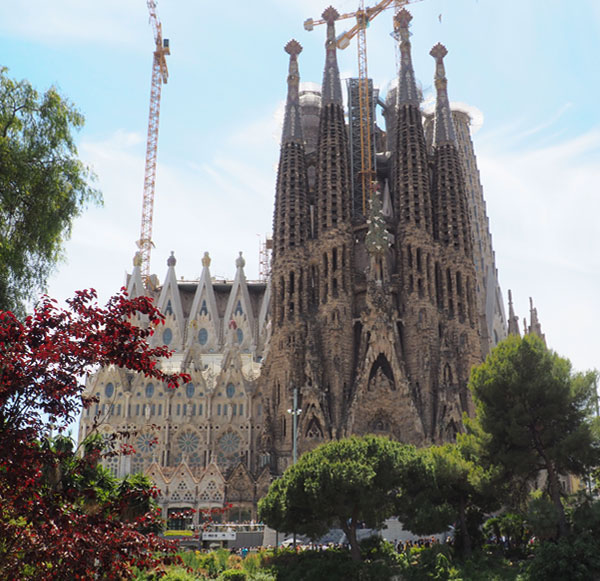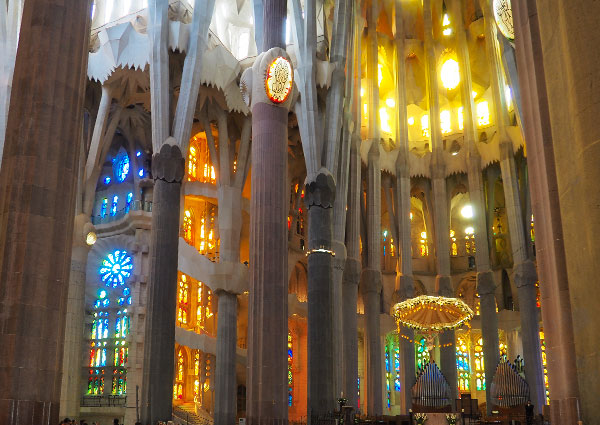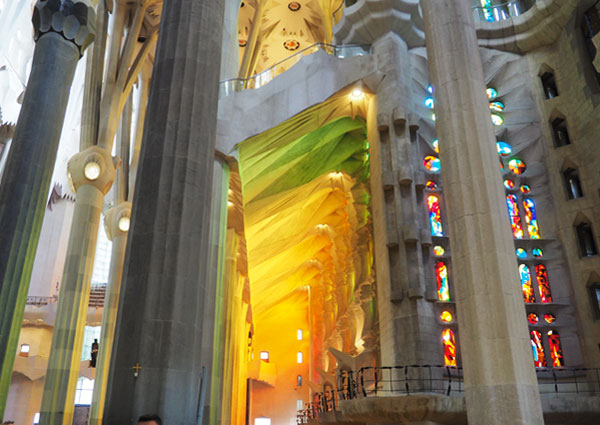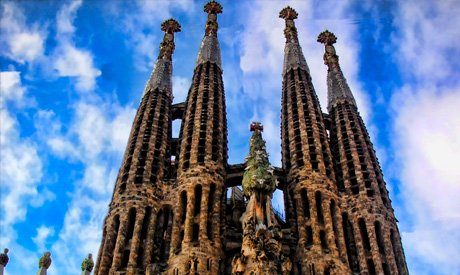History of the Sagrada Familia
The expiatory temple of the Sagrada Familia, the construction of which commenced in 1882, is today one of the emblems of Barcelona, known around the world and visited by millions of people. The part built by Gaudí was declared a UNESCO World Heritage Site in 2005. The Construction Board hopes to finish the works in 2026, marking the centenary of Gaudí’s death.
In 1881, thanks to donations, the Spiritual Association of the Devotees of Saint Joseph bought a 12,800 m2 plot to build the temple. But the first stone was not placed until 19 March 1882, on Saint Joseph’s day. Initially, the project was commissioned to another architect, Francesc de Paula Villar, but Gaudí assumed the position at the end of 1883. His new project was much more ambitious than that proposed by his predecessor. It included the construction of a temple with 5 naves, a transept, an apse, an exterior ambulatory, 3 façades and 18 towers. It was the most complex and unique project that Gaudí had carried out throughout his professional career, to which he dedicated 43 years of his life.
Did you know that initially Gaudí only completed building on the Nativity façade with its 4 towers because he knew that he would never see it finished?
The work of Antoni Gaudí, who wanted to create the perfect temple, presents the life of Jesus and the history of faith. The 18 towers are dedicated to important biblical figures, and this is reflected in their size: 12 of them represent the apostles, 4 the evangelists, one the Virgin Mary and the highest of them all represents Jesus Christ, which will be topped by a cross reaching a height of 172 metres. When it has been completed, the Sagrada Familia will be the highest building in Barcelona and the highest church in the world.

From 1914, Antoni Gaudí ceased his work on civil projects and focused solely and exclusively on the construction of the temple. On 30 November 1925, construction of the first bell tower of the Nativity façade was completed. This is the only one that Gaudí would see, as on 10 June 1926 he died as the result of a tragic accident that occurred three days earlier, when he was run over by a tram. The Nativity façade was finally finished in 1930.
Did you know that the Sagrada Familia had schools for the children of those working on the temple?
Following Gaudí’s death, his disciple Domènec Sugrañes took over construction until 1938. Despite his willingness, during the Spanish Civil War there was a fire in the crypt, which also affected the provisional schools and the workshop where Antoni Gaudí had left all of the plans and models for others to conclude his work. This information was not entirely recovered, so we will never fully see what the architect had envisaged.
Did you know that it took 22 years to build the Passion façade, the temple’s second façade? Construction started in 1954 and it was finished in 1976. They tried to build it as close as possible to what Gaudí had in mind.

Architects and evolution of the works
Since his death, several architects have inherited Gaudí’s legacy. Besides Domènec Sugrañes, work has also been undertaken by Isidre Puig Boada, Lluís Bonet i Garí, Francesc de Paula Cardoner Blanch, Jordi Bonet Armengol and Jordi Faulí Oller, who has held the position since 2012.
Did you know that the Sagrada Familia will be the highest building in Barcelona and the highest church in the world with a height of 172 metres?
Like all expiatory temples, sources of revenue for the Sagrada Familia can only come from donations and personal contributions. Thanks to this income and to technological advances in construction, it is possible for the work to be finished within the established term. Since the year 2000, vaults have been completed structurally and closed, the foundations of the Glory façade have been laid, the Passion façade has been completed, with the participation of Josep Maria Subirachs, and the Japanese sculptor, Etsuro Sotoo, is completing the decoration on the façade.
On 7 November 2010, Pope Benedict XVI visited the temple, declaring it a Basilica and officiating a solemn mass.
As already mentioned above, it is planned to finalise the construction by 2026, marking the centenary of Antoni Gaudí’s death. A moment that will be emotional for Catalans and devotees alike. It will have an even greater significance if Gaudí is declared as the Saint of the Catholic Church, a proposal launched in 2000 by the Association for the Beatification of Antoni Gaudí.

Why visit the Sagrada Familia
The Expiatory Temple of the Sagrada Familia is the final construction in Gaudí’s career, a unique place in Barcelona that will become the highest Basilica in the world once work has been completed. A Gaudí masterpiece that has been under construction for over one century.
Among many other wonders of this work is the spectacular play of light and colours that can be appreciated inside the temple when rays of sunlight enter through the stained glass, a world of sensations that changes depending on the time of day.
Did you know that the Sagrada Familia can be seen from Casa Batlló and La Pedrera?
It is also possible to visit the towers of the Sagrada Familia to enjoy unique views of the city. Many people ask which is the best tower to visit. In actual fact, one is not any better than the other, but there are differences. In the case of the Tower of the Nativity façade, dating back to Gaudí’s time, there is no lift to the very top, but it is possible to climb a narrow spiral staircase, which is not suitable for all visitors.
For visitors who are not in a good physical condition or for those who have a phobia related to small spaces, it is better to visit the Passion Tower. Either way, no visit to the Sagrada Familia is complete without visiting the towers, a hugely important element in Gaudí’s work, as it was the closest you could get to heaven.

How to get to the Sagrada Familia
C/ de la Marina N 41º 24´ 283´´ | E 2º 10´486´´
Metro L2 and L5 Sagrada Familia. / Bus 19, 33, 34, 43, 44, 50, 51, B20 and B24.
General entrance: general entrance at the Nativity façade, on c/ de la Marina.
Opening hours of the Sagrada Familia:
From November to February: from 9:00 to 18:00.
March and October: from 9:00 to 19:00.
From April to September: from 9:00 to 20:00.
25 and 26 December and 1 and 6 January: from 9:00 to 14:00.
